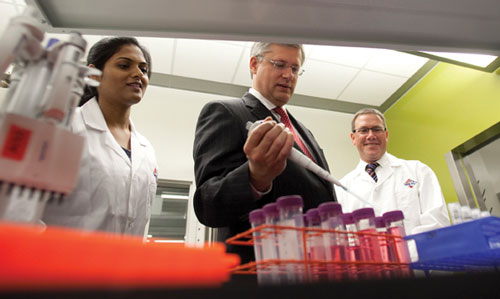 During the past decade the world has been challenged by a number of emerging and re-emerging infectious diseases affecting both humans and animals.
During the past decade the world has been challenged by a number of emerging and re-emerging infectious diseases affecting both humans and animals.
Examples include SARS, tuberculosis, avian and swine influenza, West Nile virus, and neurodegenerative prion diseases including bovine spongiform encephalopathy (i.e., mad cow disease) and chronic wasting disease.
In addition, an estimated 180 million people worldwide are infected with the hepatitis C virus and 34 million with HIV, the causative agent of AIDS. Canada, in particular Ontario, Saskatchewan, Alberta and British Columbia, is all too familiar with the socio-economic impact of these diseases.
SARS cost Canada (primarily Toronto and Vancouver) $1.5 billion; BSE cost the Canadian cattle industry (primarily Alberta and Saskatchewan) over $6.5 billion; hepatitis C, costs the Canadian healthcare system about $1 billion annually. A beef cow from BC recently tested positive for bovine TB – a reportable disease by CFIA – in a US packing plant. This could have shut the Canada US border, but fortunately it was viewed as an isolated incident.
The herd was destroyed. Microbes are the ultimate opportunists, striking stealthily and spreading quickly making the worldwide impact of these diseases astronomical. Research to address the underlying mechanisms that pathogens use to cause disease has been hampered by the critical shortage of appropriate facilities in Canada and around the world. Because of their capacity to produce serious disease and the fact the majority of these diseases are all transmissible between species (zoonotic) they need to be studied in a higher level of containment than is commonly used for infectious diseases.
This is termed Level 3 (CL3) or Biosafety Level 3 (BSL3). This containment includes special engineering design features to ensure the safety of the personnel and the general public while advancing research and development. Aside from the excellent federal facilities located in Winnipeg and Alberta, capacity in Canada to study CL3 diseases in large animals is relatively limited. This has impeded our ability to develop much needed vaccines and to generate data needed to guide public policy.
Canada’s new $140 million International Vaccine Centre (InterVac) at the University of Saskatchewan’s Vaccine and Infectious Disease Organization provides CL3 capacity to work with all types of diseases in an aim to improve the health of animals and humans. Housing 18 CL3 isolation suites, six CL3 laboratories, a select agent lab (for agents that have potential use in biological terrorism) and a dedicated CL3 aerobiology lab, InterVac is one of only three vaccine research facilities in Canada that can house large animals and is one of only a few in the world with the capacity to generate statistically sound data suitable for the regulatory approval of vaccines and other anti-infective compounds.
InterVac partially offsets the international shortage of CL3 laboratories and helps keep Canada on the forefront of infectious disease research and vaccine development. This creates huge beneficial opportunities for both human and animal health. Vaccination is widely accepted to be the most cost-effective way to control infectious diseases and reduce health care costs with an estimated benefit:cost ratio of 5:1 in direct health care and 17:1 including societal costs. Vaccination is routinely stated to have done more to reduce human mortality than any other healthcare intervention.
This importance of InterVac to Canada’s strategic advantage was recently highlighted by the attendance of Prime Minister Stephen Harper; Saskatchewan Premier Brad Wall; and Saskatoon Mayor Don Atchison during InterVac’s grand opening celebration and the commencement of Canada’s National Biotech week on September 16, 2011. All three governments have invested substantially in the capital costs of the facility.
Once the facility is certified and reaches full operational capacity, scientists from Canada and around the world will be able to utilize InterVac to research new infectious disease threats and develop strategies to mitigate the risk to humans and animals through novel anti-infective therapies and vaccines and by providing additional information for those with an interest in helping define government policies. Canada has been very successful in both the development of new vaccines and creation of immunization strategies internationally.
These successes include the work of Connaught Laboratories on polio immunization, the National Research Council of Canada’s novel vaccine technology for meningococcal disease, and the Vaccine and Infectious Disease Organization’s six world firsts in the animal vaccine sector. InterVac’s contribution to the health of Canadians and to the economic competitiveness of Canada’s vaccine sector will be significant. The work that will be carried out at InterVac will build on a rich history of Canadian successes in the vaccine field and will help ensure that we retain our competitive advantage.
The next challenge
Nobody can predict what the next infectious threat is going to be or when it will occur, but it is generally recognized there will be one and the odds are it will be a level 3 zoonotic agent. InterVac is a principal asset in Canada’s infrastructure to help ensure we are prepared as a nation.
Photo credit: Biotechnology Focus.Reprinted with permission, Biotechnology Focus February 2012. Check out the digital edition of Biotechnology Focus.
For more information on VIDO InterVac, please visit their website or contact: Vaccine and Infectious Disease Organization – International Vaccine Centre (VIDO-InterVac) University of Saskatchewan Saskatoon, Saskatchewan Telephone: (306) 966-7465.